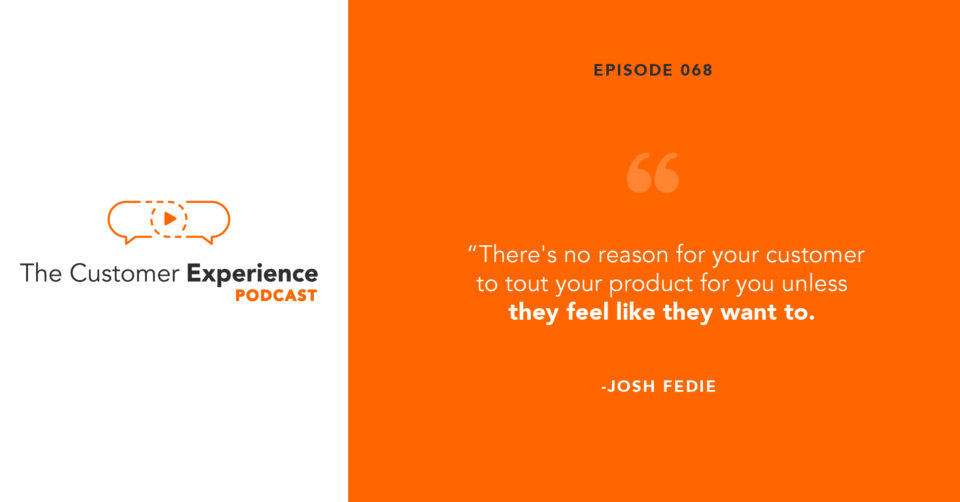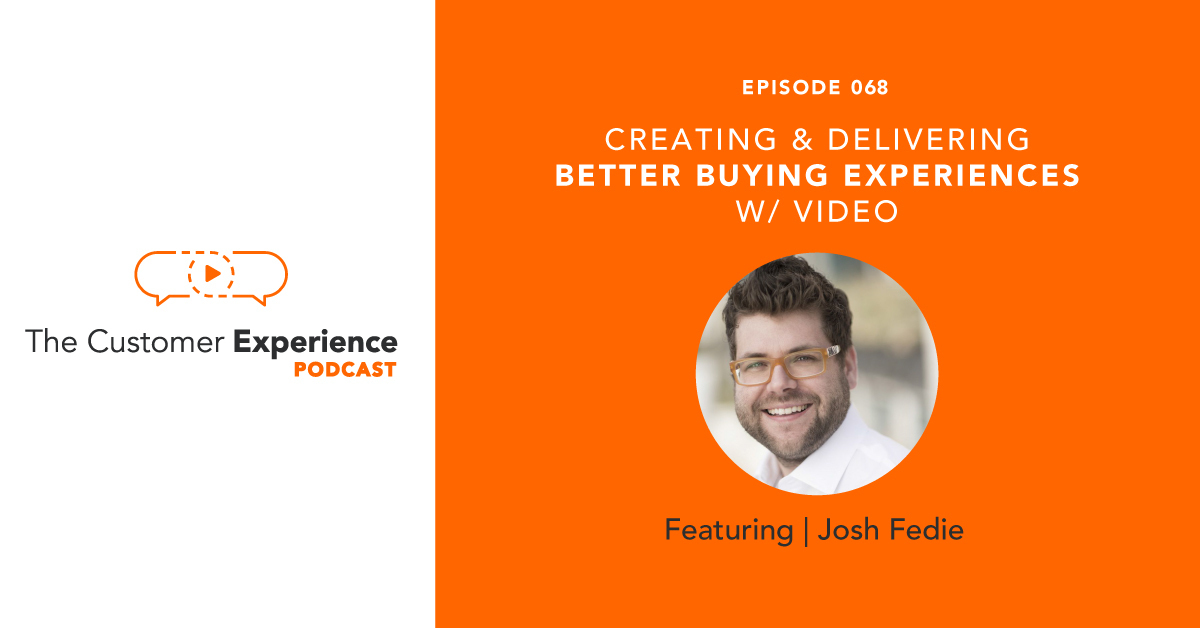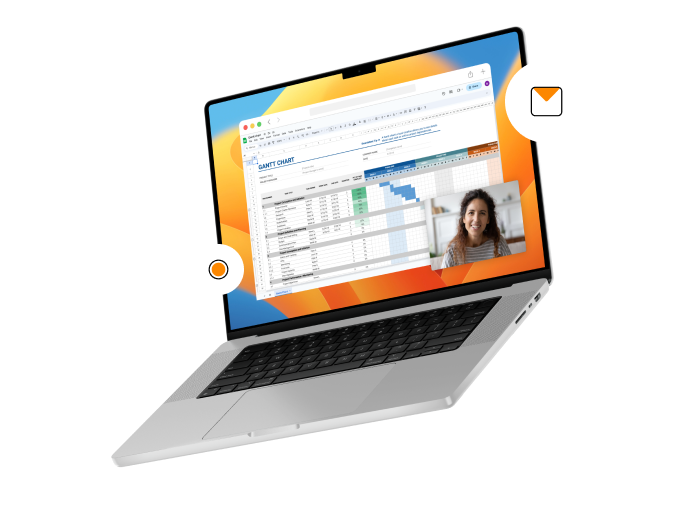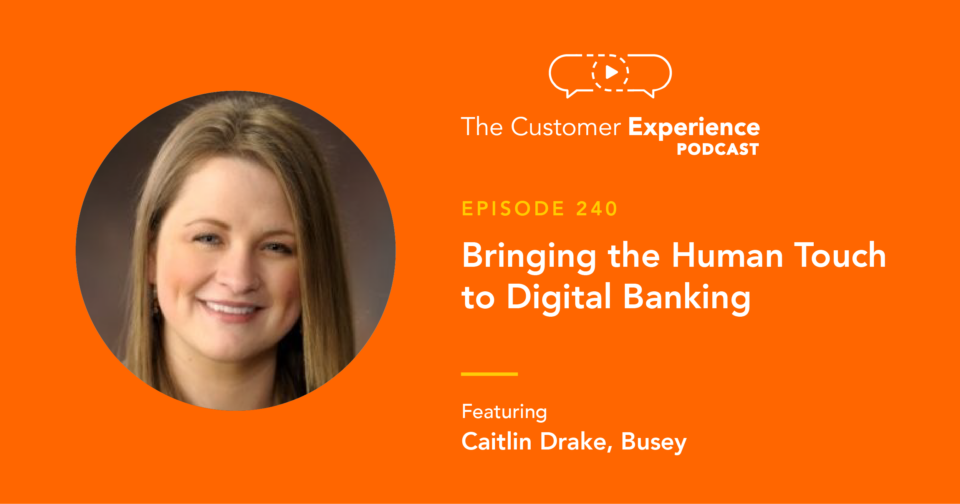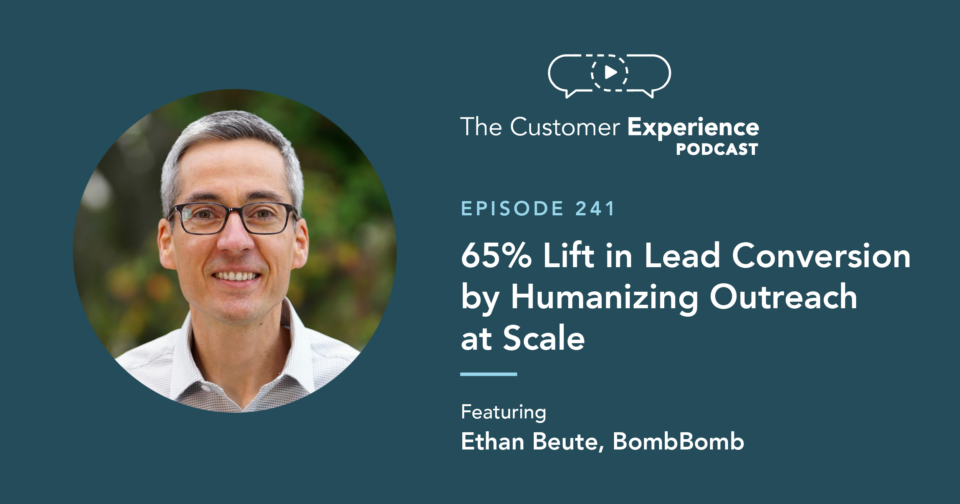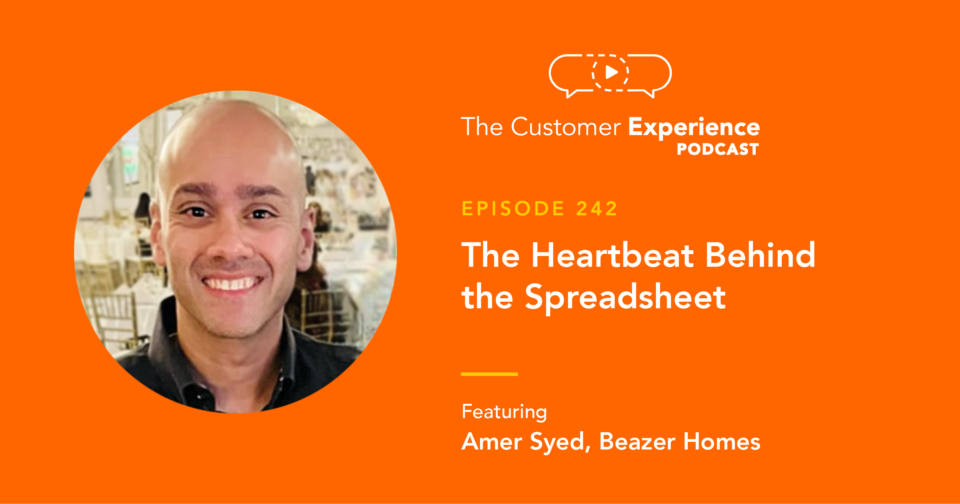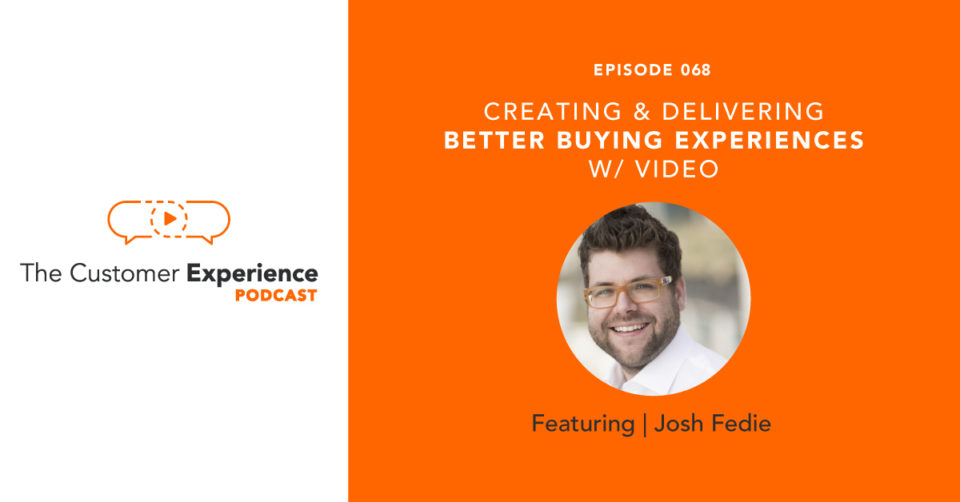
Apple Podcasts | Google Podcasts | Stitcher | Spotify
Buyer’s remorse is a seemingly inevitable feeling after a purchase or commitment. It’s happened to all of us. What can we do to create buying experiences that reduce or even eliminate this remorse? And how do we empower buyers to give them an optimal customer experience?
How do we create and deliver better buying experiences that shape the trajectory of our businesses?
We answer these important questions and more on this episode of The Customer Experience Podcast.
Our guest, Josh Fedie, brings his extensive sales and marketing expertise to this conversation centered around the buying experience. As a matter of fact, he founded his latest company, SalesReach, because “buyers have changed, salespeople matter, and marketing shouldn’t have all the fun.”
He crafted his business to make life easier for customers, not harder. From a little Wordpress page in the distant past to today’s visual dropbox full of video and other useful assets, his idea has evolved to deliver truly personalized buying experiences.
In addition to founding SalesReach, he’s the host of The Founders Mentality.
Throughout our conversation on buying experiences, Josh shares insights and takeaways on:
• Why CX is defined by how we make people feel
• How to tackle buyer’s remorse
• How to leverage your customers to enhance your product or service
• Two ways to “personalize” your messages and experiences
• What evangelists do for buying experiences
• Why and how to get started with video
Better Buying Experiences
Hear the entire conversation with Josh Fedie right here:
Prefer to listen outside of this blog post?
Download The Customer Experience Podcast in your preferred player:
While you’re there, please take a minute to subscribe, rate, and review the show – it’s extremely helpful.
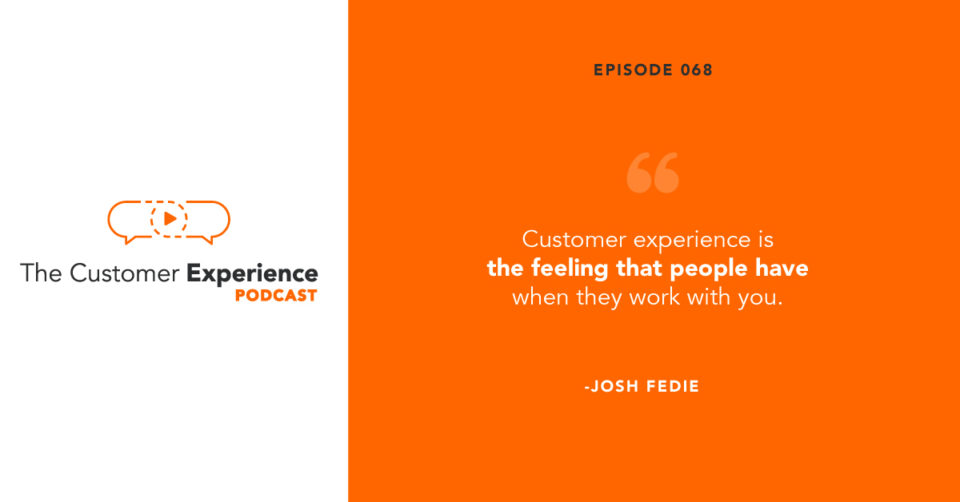
Full Transcript: Creating Better Buying Experiences with Video
Ethan Beute:
The customer experience often starts at or near the buying experience. So today, we’re going to be talking about creating and delivering better buying experiences. Our guest brings more than 20 years of sales and marketing experience in digital marketing and tech. Most often as director of business development, but also, as two-time company founder. So why did he found his latest company, Sales Reach? In his words, “Because buyers have changed, salespeople matter, and marketing shouldn’t have all the fun.” Josh Fedie, welcome to the customer experience podcast.
Josh Fedie:
Hey, thanks for having me on, Ethan. You did your homework before this one. That was good.
Ethan Beute:
Well, LinkedIn makes it easy. I do spend time in advance. I want to have good conversations and I want to feel a little bit like I know you before we start talking. A, it’s a show of respect to you for sharing your time and expertise with me and listeners. But B, it makes it a little bit more fun and well, in some ways easier to do as well. So, thank you for noticing.
Josh Fedie:
Yeah.
Ethan Beute:
And it’s easier than ever. Especially for someone like you that’s publishing a lot. Which brings me to before we get into CX, before we get going, I was watching Episode four of your new video series on the rocks. And you mentioned a few people I really like. Kris Lindahl, Todd Hockenberry, and a previous guest on this podcast, Dan Tyre of HubSpot. So I thought just to warm it up, could you tell me a story about one of those guys? and bonus points if it has a CX angle. It doesn’t have to.
Josh Fedie:
Dan Tyre is one of my favorite people in the world, if I’m being totally honest. And I’ve said this before so people probably think, “Oh, that Josh he’s a broken record,” but I believe in giving respect where respect is due. I would not have started the business that I started today without Dan Tyre. And I mean that with every ounce of my being. He was the person that was giving me the sales training on the HubSpot platform. I was going through Dan Tyre’s YN bootcamp. I can’t remember the exact name of it, but he was super inspiring and as we’re going through all this training, he had brought to light a product that I’d created many years ago for myself. With no intention of ever productizing it. Didn’t really see that there was a need for it in the marketplace. But as I was going through the training through HubSpot, I realized that the thing I’d created was huge gap in the marketplace.
Josh Fedie:
It wasn’t something that HubSpot was offering. I started digging around to see who else was making it. And at the time, no one was really making it. And so I flew out to Boston and asked Dan, I said, Look, I just need 15 maybe 30 minutes with you. I just want to show you the MVP of what I had built 10 years ago. And I want to tell you what I plan to do with it. I just need someone to validate this one.” And that meeting did a lot for me. He validated the idea, almost immediately. He did not agree to be an investor which was fine, because it also taught me how to properly try to raise money very quickly. But he has stayed available to me ever since that day just over two years ago. I have his link to his calendar. He’s made it very clear I can grab any time with him whenever I want to talk to him. And I’ve used that to my benefit, to continually utilize him as an unofficial advisor in my business, and it’s been invaluable, honestly.
Ethan Beute:
That’s awesome. I’m so glad I asked that. And he’s definitely one of those guys that walks his talk. Of course, he’s got a mountain of energy. He probably needs you on his calendar just to burn some of that energy off.
Josh Fedie:
Yeah. Yeah, absolutely. Absolutely.
Ethan Beute:
That’s awesome. What a good dude.
Josh Fedie:
Yeah.
Ethan Beute:
So let’s get into CX, and we’ll probably get into that product idea as well. I do want to know more about it. But let’s start just to set the scene, when I say customer experience, what does that meant to you, Josh?
Josh Fedie:
Yeah, it’s the feeling that people have when they work with you, for me. And for me, that is absolutely everything. I want to be memorable, I want to be deliberate, I want to be intentional, I want to be strategic. I want people to walk away from any interaction I have with them feeling that way.
Ethan Beute:
Nice. And talk about those feelings. I’ve been thinking about this a lot, and I did a short self episode on it. It’ll release just before or just after this conversation. And I boil the whole thing down to the same thing. It’s how we make people feel. And the angles on it, are of course how they feel about us. But then there’s also how they feel about themselves by spending time with us. There’s so many… the feeling just goes in a variety of directions.
Josh Fedie:
Yeah, that’s a super important clarification that you just made there, because you do need to be looking at in my opinion and it sounds like yours, in both ways. It is not just how they feel about the sales professional or the company that there’re moving forward with. But the feeling that they’re empowered. That they made the right decision after moving forward. The most human thing is buyer’s remorse. The second we buy anything, every single one of us, has a certain amount of buyer’s remorse. No matter what we’re purchasing. There’s always the question of did I need that? Did I need the turbo on this car that I just bought? Or could I have gone with the S version of this car? Right? Why did I have to get that version? It could even be a pack of gum at the Home Depot on your way out. Did I really need to buy that?
Josh Fedie:
Buyer’s remorse sets in immediately. And so it’s honestly all customer-facing teams need to really step things up because the buying experience is not just me as a sales professional. There’s going to be a handoff to the onboarding implementation, customer success team, whoever comes next in that line of command. And that’s almost the most, in my opinion, the most critical time to make sure that everything is turning on all cylinders here. Because the second a ball is dropped, after that money changes hands, that’s when that buyer’s remorse goes into the red zone. Immediately. And we’ve all had that experience where immediately after landing the deal, someone comes running in the room and says, “Hey take it off the leader board. You lost that deal.” Why did I lose that deal? Did I overpromise? Who under-delivered? What happened here? But that buyer’s remorse is real and we need to find ways to make people feel empowered in the decision that they’re making so that they move forward with less regret.
Ethan Beute:
Yeah, really good. Buyer’s remorse is super powerful. I feel like depending on the price point or the product or the service and the anticipated impact, you’re on the clock as soon as that invoice is signed or the credit card is swiped, or whatever the case may be. And so in some cases, you’re on the clock the next 72 hours and in other cases, you’re on the clock over the next three weeks or maybe even three months. But that clock is moving and managing the confidence. All the excitement that they had going into this start of the clock there, needs to be sustained.
Ethan Beute:
So Sales Reach, I assume that that is the idea that you had. And it was obviously coming out of a felt need that you were experiencing at the time. Maybe give us a little bit of that arch, I guess. I was going to initially go in with who is your core customer and what are you solving for them? But I have a feeling if you kind of tell the story a little bit… Because it sounds like there’s a story there that I would love to hear, that that might emerge naturally out of that.
Josh Fedie:
Yeah, the arch, where this came from, was when I owned my first business. I had a marketing agency. I knew enough about coding to be slightly dangerous. And every single day I was becoming more and more dissatisfied with my sales process. This was years ago. This is before Sales Force was a household name. Before HubSpot even existed. This was years ago. So I didn’t really see that this was something that other people would need. But what the problem was, was that I was falling to this call and response with my prospects. They would ask me for things, I would send them those things. I would feel like I did my job, but then there would always be this confusion. They’d come back to me months later, Hey, we’re about to go in front of the review team, I could have sworn you sent me something about this. I can’t find it. Can you resend it for me?” “Yep, no problem. I’ll resend it.”
Josh Fedie:
And it was then that I’ve realized that I’m making your life challenging. Why am I doing this? I know enough about coding to make something better for you. So what I started doing was just making simple word press web pages that I would stand up for every single prospect that I had spoken with. And when they needed something from me, I would load it on to that page. It was very rudimentary. But it made it simple for them to have one source of truth for everything they needed to share with their team. That’s where it started.
Josh Fedie:
And then, the advent of things like personal branding started popping up. And video based sales, one-to-one sales efforts, you know all about that. And that’s where I started seeing, hey, there’s a need for the core product of what I’d built, with some additions for the modern sales professional to meet the modern buyer the way they want to interact. We live in this world right now where the same consumer on Amazon is your consumer right now as well. And everything is so simple for them in that digital space. They’re comfortable in that digital space. They don’t have to be put in a corner where they have to talk to this sales person that’s telling them what they need. They’re making decisions on their own. So, why are we pulling them out of those spaces?
Josh Fedie:
That’s when I decided to pull together a team, start building this, validate it with some early customers, see if pulling all these components together, your personal branding, personalizing the materials that you’re sending to somebody, organizing this process for them so that when it’s brought to the decision making table, they have everything in one source of truth. And then infusing it with personalized video as well so that you can help narrate the situation however you need to at every stage of the sales process, in your own words.
Ethan Beute:
Love it. So how much more, from an experiential standpoint, I can visualize a very, very simple word press page. Maybe a little headline and a link. Headline, link, headline, link.
Josh Fedie:
Yeah.
Ethan Beute:
What does it feel like now to visit one of these sites and when in the relationship do you start building one of them?
Josh Fedie:
Yeah, so first question, what does it look like? I like to say it’s a visual Dropbox essentially. Dropbox is a great way to send a whole bunch of information to somebody, but there’s things that get in the way. Before they can look at the documents, they have to download them. There’s nothing visual about it. All it is a title of the material that you’re sending them. So there’s a very visual component to this whole thing. The beauty of the visual portion of this is that it is locked down by marketing teams. So what we’ve created is a software that marketing teams can kind of set it and forget it. It’s the Ron Popeil chicken fryer methodology. Right? Set it and forget it, hand it off to your sales team, you don’t have to worry anymore because they’re enabled now to put whatever they need on the page.
Josh Fedie:
It’s already been approved by you, the design is already set in stone. They change the color scheme on the page. It’s all locked in on your branding element, so that’s kind of how it is. It’s a visual CRM is what it is at the end of the day. What was the second question again, on that?
Ethan Beute:
When in the relationship are your customers setting these up? Because I can see this being incredibly useful way, way, way at the beginning of the journey. And then of course, as the account continues to grow and the relationship matures, I can see and account manager or CSM having a lot of value in it as well.
Josh Fedie:
Yeah, you already get it. And you can use this product whenever you want, Ethan. But no, you set it up, right, from day one. There’s no reason not to. You can actually use this on more of a, you should never do a cold outreach, but you can set this up on a warm outreach, very early on. The page builds as you need it to build. You don’t have to send out a page with literally all the bells and whistles on it. It could be as simple as a way to get on your calendar, a personalized video to let them know why you want to meet with them, maybe a couple materials, but for sure your bios so they know who they’re going to be talking to.
Josh Fedie:
And then as the relationship grows you add to this page. The page auto-updates no matter how you change the things in the asset library, the page auto-updates. You can change it dynamically throughout all the conversations. And then, where I was talking about all customer-facing teams, that’s really who uses this product. It’s not just a business development tool. It then turns into a client relationship management tool, or an onboarding and training portal, or even recruiting. We’ve seen some of our customers use it in their recruiting efforts, to make the recruiting process even more personalized. So it’s been pretty cool to watch that.
Ethan Beute:
Yeah, that is a really fun thing. And I would say we’ve had a similar experience here at BombBomb where you have the, this software was built and the company was built in part out of the same thing. Felt need by one of our co-founders in a sales role. Wanted to get face to face more often. Had too many clients spread over two wide a geography. Let’s record and send videos, and oh by the way, I guess a lot of other people could use this too for the same reason that I did. And then all of a sudden, you turn it lose into the world, and customers start doing things that you didn’t anticipate, and it’s just delightful. And the recruiting layer, by the way, makes perfect sense. I’ve been teaching a lot about video across, essentially a bow tie funnel. Customer journey against a bow tie funnel or a life cycle, and you can map the exact same thing. The employee life cycle is exactly the same as the customer life cycle. Just some of the terms are different. But it’s the exact same thing if you’re doing it well.
Ethan Beute:
One currently working out in my head, by the way, is the same thing but for a personal network thing. This isn’t a sales relationship, it’s not an employee relationship. But there’s some point in yours and my relationship, Josh, where we have some kind of a level of commitment and then this positive thing. Or, it fades out in the beginning. We’re not going to go that way. There’s something about a personal network too, not that your product would be necessarily be appropriate for it, but I guess some could apply it to some of their personal relationships as well.
Ethan Beute:
So obviously alignment is a big theme on this show. I imagine it’s something that you have a lot of thoughts and experience around. We’ve already talked about the alignment of communicating with a client, marketing maybe in the early stages. Into sales, BDR, SDR, AE, hand off to CSM account management. When I say alignment, what comes to mind? Is it a played out term? Is it actually fundamental to the success of any business? What do you think about alignment?
Josh Fedie:
Two things. A, yes, it’s fundamental to the success of any business. And B, it is the most misunderstood thing in the entire world for companies. And it’s painful to watch. I’ve worked in enough companies in enough different roles, where I’ve seen misalignment in so many different ways. And even being in all those different positions, I don’t have the answer for how do we better align ourselves. But what I believe the answer is right now, is that we need to find technologies that we can utilize throughout the customer life cycle that make it simple. And the core word is simple. Because we tend to make things way more complex than they actually need to be in companies. And many times, the best answer is the simplest answer.
Ethan Beute:
Right. There is no magic to it. When you say misalignment, give me one or two stories. And I don’t mean unpack horror stories that include the names, but so people can feel the, “Oh, yeah, yeah, yeah.”
Josh Fedie:
Yeah, okay. So this has happened. Probably the worse case that this has ever happened in my personal life… Names will not be mentioned. I can’t mention names.
Ethan Beute:
Please don’t.
Josh Fedie:
Yeah. We’ll protect the innocent on this one. Regardless, big deal. Closed a big deal. It took many, many months to wrap up this deal. It was a large contract for a large price tag, and so I involved many members of the organization I was at, while this proposal was being created. I’m a big believer in making sure that everyone understands exactly what we’re selling in here before we move forward. However, I do not think that the respect was given to the review process of our agreement before we put it in the customer’s hands. Because immediately after landing that deal, it was within about a month, the customer started asking questions. “Well, when are we going to get to this piece? When we are we going to do that? Josh said we were going to do that.”
Josh Fedie:
And the team was coming and saying, “Oh no, no. Oh, I don’t think Josh said that.” I kept getting pulled forward and I’d pull out the agreement and I’d say, “Guys it’s right here. It’s right on the agreement here. Yes, I promised this, and this is part of what we say we do here, so we should probably being doing this for these people. This is what they paid us for. This is why it cost so much money to move forward in this contract.”
Josh Fedie:
At the end of the day, that deal was salvaged, however, there were some discussions about potentially having to have legal teams intervene, and I don’t think that I left that place before that deal, to see what ended up transpiring with that deal. It was just part of an ongoing issue, that I had to get out of there. But, I don’t think that you can ever really salvage a relationship that starts off that way. People will always have that in the back of their minds, and honestly it could have been alleviated by, A, better review of what we were actually delivering to this customer before we moved forward. B, I learned that I probably should have done a better job when it went from sales to onboarding and the customer support team properly communicating, this is exactly what’s going on here.
Josh Fedie:
Instead, on that deal specifically my process was, you’ve already reviewed this agreement in detail correct? Yes. Awesome. Here’s the signed agreement, move forward, I’m on to working on the next deal. Big mistake on my end.
Ethan Beute:
Yeah, I like that you said properly communicating. I think as you were sharing that I kept thinking I feel like just clear communication but it’s more than that. It’s shared values. It’s maybe where I’ve seen some miscommunication and misalignment is around one-off stuff that is, it’s not repeatable. You’re going to wind up rework each time you do it. A unique deal that just doesn’t make a lot of sense. Here’s another term that I think… Did you call alignment, misunderstood?
Josh Fedie:
Yes, absolutely.
Ethan Beute:
Okay, here’s another term that I think is misunderstood that I feel confident that you have something interesting to offer on. And that is personalized. What is a personalized experience in your view?
Josh Fedie:
Yeah, yeah. Look, there’s two different ways to look at personalization in your process. And I think that this is where the confusion happens. There is confusing yourself and your personal character and who you are and what you stand for. Your personal brand. Infusing that into your process. That’s half of personalization in my mind. But the other half, the most important half, is where you stop talking about yourself, and you start delivering materials that are personalized to the person that you’re sending it to, to address their unique challenges. And if you don’t do both of those things, A, you don’t build the trust. Because they don’t know who you are, they don’t care who you are, it’s just a thing.
Josh Fedie:
But if you don’t deliver what they actually ask for, what they actually need. Amazon does a great job of this. There is a very good reason why every time you go to Amazon, and you select anything, it’s says, “Customers that bought this also bought this. Are you interested in that?” That’s how they help personalize this. That’s how they let you know, we understand you. You’re purchasing a mop, you might also need a bucket, and you might also need some soap. Because everyone else that bought a mop did too. We’re going to be helpful here, we’re going to make a guess that this is what you need. Right? Sales people need to be strategic in that same way. If somebody reaches out to you, and says, “This is what I need.” You need to dig into it a little bit more.
Josh Fedie:
And what if you just use the Amazon model? Well, the last customer I spoke with that needed that, also needed this and this. Could you also use that? Oh wow, I could actually use, I wasn’t even thinking about that. Well, there you have it. Kris Lindahl, who’s a big fan of BombBomb and is going to be on my podcast here soon, I love that guy. He’s great. He was just on my friend Mickeli Bedore’s podcast called Coffee and Closers. He said something absolutely profound. He said that he loves to look at industries outside his own, when he’s trying to decide how to move forward. How to innovate. How to truly innovate in his space. And I thought that was absolutely profound.
Josh Fedie:
I think a lot of us do this without really thinking about it but I think the sad reality is, is that a lot of us don’t do this. A lot of us, just kind of look at our exact competitors and go, “Well, if BombBomb’s doing this, then Wistia should be doing this. And if Wistia then TwentyThree should also being doing.” No, no, why don’t we look at, why don’t we as BombBomb look at Uber? What could Uber teach us about the customer experience? Because I guarantee there’s something there, we just have to be willing to pay attention to it, and dive a little deeper, and think a little bit more intentionally.
Ethan Beute:
Yeah, really great. I love that in addressing personalization off the top there, that you went to Amazon. Because what I think a lot of people go to in their heads is, “Oh my gosh. I have to do all this work and it’s not enough just to slug in the variable data of their company name and their first name and their industry name. I actually need to go read a LinkedIn profile and maybe see if they were a guest on a podcast so I have something personal to talk about.” And that’s true but there also… and I’ll tie alignment back in here too as something I imagined as you walked that out is, there is information because this, “Oh, you bought a mop. Maybe you need a bucket.” And so you have that curiosity for starters is the word that came to mind. This curiosity to say, “Oh, that’s interesting. Why do you think you need that?”
Ethan Beute:
Oh, well, maybe you need this and that. But then also kind of closing that loop because the customer success, customer support, customer service account management, AE’s, or sorry account managers, AMs, have information about customers that have fed back up earlier in the process is going to teach sales and marketing a lot more about how this actually pans out. And so, personalization is scalable in a lot of ways and it doesn’t just mean spend a bunch of time doing a bunch of researching figuring out what their favorite coffee cake is so you can send it to their office on a Wednesday morning and delight them. That’s not a bad thing to do either, but personalization doesn’t have to be completely time consuming and manual.
Josh Fedie:
Yeah. And what I would throw out there as well, as long as we’re throwing out words, right, and riffing off of words. The word that I like is visibility. Visibility throughout the organization is what helps you be more intentional and personal in your efforts to deliver more value with every interaction. Because, look, if I’m just in a sales capacity, my job is to find leads, land deals, pass them on, rinse and repeat, all day long. And many organizations keep the sales person doing that all day long. Now that you’ve handed this off, you’re out. Now we have a customer success manager, this is their role, don’t get in the way. Don’t do that. That’s the worse thing you can possibly do. Because if I don’t have visibility, as to what happens next after I’ve handed that off, that’s where you have issues like the story I told earlier. Right?
Josh Fedie:
I don’t know that I need to explain this more intentionally to my internal team if I don’t know you’ve been having the issues doing the things I’ve been selling in at this company. You need to give me the visibility to do that. Additionally though, on the good side, I need visibility to the good things that happen as well post-sale. Because that’s how I can double down preemptively bringing bigger dollar amounts because I know that if I land this person that does this, there’s a 90% chance that they’re going to also need this and this. I might as well make it part of a package right now, so they don’t feel like we’re continually upselling them after the deal.
Ethan Beute:
Yeah. Or that we misunderstood them and we held back opportunities and whatever. It’s better for everybody.
Josh Fedie:
Yeah, absolutely.
Ethan Beute:
That’s really good. And before we move on to another topic, I’ll just double down and say, yeah, Kris Lindahl, I’ve always regarded him as kind of a marketing genius. Savant might be too far, and I think what you offer there is more of an illustration of the genius because he does a lot of natural instinct there but this idea of intentionally seeking out new influences and new voices and new perspectives to broaden that… The creativity happens in taking two seemingly disparate things but somehow they just collide together in your brain, which is where part of the genius and creativity happen. The more you vary your input, I think the more interesting the output is going to be at least from a learning and development and creativity standpoint.
Ethan Beute:
Let’s talk just briefly, go to market. Are you more product-led, sales-led, marketing-led, how do you regard that? Do you think a lot about it, or how did you… And I’ll just back it up one more step. You had this idea, it was validated, it was clearly a good idea. You had a clear use case for it, so you’re like, “Now we’re going to bring it to market.” How did you think about all of that?
Josh Fedie:
Yeah. I was very intentional with our go-to-market strategy. It was all about storytelling. So I suppose that you could say, we’re a marketing-led organization. However, I would say that salespeople should also be storytellers today. We’re a sales and marketing-led organization. I’m super proud of the product that we’ve created and the product proves itself every single day. So when I tell the story about the benefits that this is going to bring your organization, when I tell the story about the challenges that you’re likely facing, and the reason we created this, the product has to make good on that story and that promise. And so we’ve been really, really blessed in that. We have not had the churn rate that many SAS companies have. When people come in, it becomes part of the grain of their company pretty quickly.
Josh Fedie:
We started as a sales tool, that’s why we called it Sales Reach, and I thought this is just a sales tool. That was my own ignorance. My customers were the ones that decided this was for all customer-facing teams because our customers were the ones that started using it and all these other divisions, and then coming back to us and saying, “Did you know it works well for this?” And I’d say, “No, can you tell me about that?” And then they’d explain it to me. My customers have made this product something that I think can be a very viable company. Not me. I didn’t do it. I was the visionary that thought we could build a sales tool but turns out it’s for any customer-facing team. It responds to a lot of different needs. And we keep finding more and more people using it in more unique and interesting ways.
Josh Fedie:
We just the other day, just real quick story. With all of this COVID-19 scare going around, by the time you release this, hopefully, that scare’s over and we have moved on, but I kind of doubt we’ll have by then, unfortunately. Regardless, we were watching all these conferencing getting canceled. All of the sales teams for our customers were calling us up, saying, “Not only is our conference canceled and our trade shows are canceled, but we’ve been grounded. We cannot fly anywhere right now. We don’t want to meet with customers face to face, because who’s legally responsible if we get someone really sick and they die. What then? What do we do?” And so we were brainstorming in the office and thinking, “Wow, could our product help with these events that are now canceled to do more of a digital conference.” And so within two hours, we used our product as it stands right now, and created our own digital conference.
Josh Fedie:
Just as a proof point. An MVP of could it work or this. And it does, it’s really simple to do it actually. So now we’ve had some of these event places reaching out to us saying, “Hey, could we use that for ours? We could line up our speakers on here just like that too. Right?” Yeah. “How long will it take?” About two hours I can have it going. “Oh wow. Okay, that’s simple.” So I think the COVID-19 thing, I don’t want to say it’s going to be good for business at all, but what I do think it’s going to be good for, is I think that it’s going to force sales professionals to double down on the tools that they’ve likely had access to all along, but they really haven’t invested enough time in. We’re going to have to find ways to be more personal and intentional in our efforts without the face to face, and this is where companies like BombBomb and Sales Reach, really honestly, are probably going to win.
Ethan Beute:
Yeah, I agree. I haven’t found a really tasteful way to make that argument. But it’s right there to be had, honestly. It is. The reason we get on airplanes and spend all this money, and stay in hotels, is to get face to face with our customers and our future customers. And so with, I love your use case there and of course Zoom comes to mind. It’s what we’re using right now. Something that we use all the time here at BombBomb and then for the asynchronous stuff, of course BombBomb helps fill that gap.
Josh Fedie:
Yeah, yeah.
Ethan Beute:
I love this idea of learning from your customers. I think it is certainly something a founder or an early team member… Someone needs to be building those relationships really early on to create that intense feedback loop. So for you, and there’s a co-creation element. I’d just love for you to talk a little bit about what you think it was that made these customers so eager to share back with you or your team members what they’re doing. We’ve always had that here. It’s essentially been kind of a key part of my role as the early marketing person here, is how are actually people using this? What are the stories that we can share? Will they give us permission to share their videos. Will they come on and talk with a couple of us about what they’re doing?
Ethan Beute:
It just seemed instinctual but I think there are companies and people inside companies right now where it’s maybe not normal behavior, or they don’t have the nature of relationship that maybe you do with your customers that I know you do. Talk a little bit about how you cultivate those relationships and maybe some of the upside benefits of that relationship and that co-creation of the product?
Josh Fedie:
Yeah. So where it starts is, it starts in being available. It starts in creating not the illusion but the knowledge that you are available. There are so many organizations that exist right now, that are great companies, and I can’t name the CEO. I can’t name them. I don’t know who he or she is. They aren’t on LinkedIn. They aren’t on any channels. They’re not making any noise anywhere. They are not accessible to me. And the worse part about those organizations that usually if the CEO isn’t accessible, neither are the employees. All of this personal branding and social sharing and bringing communities together around your company, and around the mission and vision, that starts at the top.
Josh Fedie:
The top has to make it something that other people in the organization embrace and say, “Oh, that’s okay. If he or she is doing that, then I could do that too.” Right? That’s where it starts. And so for me, I was very, very intentional right from the get go. I said, storytelling already, but I wanted to tell my story. And I wanted people to know that I truly believe my central mission is that I’m not successful unless we’re all successful. There’s no reason for me to try and do all these great things, and keep it in a vacuum, and keep it to myself. BombBomb, you guys can be as successful as you want. It’s not going to take anything away from me. It’s the same way back and forth. Right?
Josh Fedie:
We should all be cheering each other on and being accessible. And when you are accessible, there’s a double-edged sword to this. Your customers expect you to be the one that responds to them. We use Drift on our website and so we created Josh Bot is our Bot, and it was kind of tongue in cheek. Because people were coming on to the chat, and they were like, “Hey, is Josh there?” And it’s like, “Well, yeah, but he’s our CEO.” “Yeah, I want to talk to Josh. I see all his videos, he seems like a nice… I want to talk to…” Well, let’s just make a Josh Bot. And then I can chime in if I have time and that works great. Right? But it builds an evangelist faster than anything in the world.
Josh Fedie:
An evangelist are the easiest sales team you can possibly create, because if a lead comes in through a passionate evangelist of your organization, you don’t even have to work on that deal. Some of the biggest deals that we’ve landed here at Sales Reach, are from evangelists that have just sent out a page to one of their customers and their customer comes back and says, “What the heck was that?” And they say, “Oh, here’s Josh’s info,” and they copy me on it, and I see the whole email chain. And I just follow up and say, “Here’s a page just for you, blah, blah, blah.” And it’s done. We just landed it. It was that easy. You can’t do that without passionate advocates. And there’s no reason for your customer to tout your product for you, unless they feel like they want to. And that’s how you build that.
Ethan Beute:
I love it. I love the evangelism or the fanaticism or the advocacy there. I’ve found that people not only will basically sell the deal for you, but they’ll also oftentimes train it and onboard it for you too.
Josh Fedie:
Yeah.
Ethan Beute:
It’s like, you’re selling I assume nationally, of course, but probably internationally as well.
Josh Fedie:
Yes.
Ethan Beute:
Right? And so you’re probably doing training, some self-serve, probably some Zoom calls or those other types of things. But the person that sold them probably lives down the street or works upstairs in the office tower, or whatever the case may be. And so they’re just even more available and of course, that’s a value add too. It’s really interesting. I’ve seen a number of our customers selling and teaching BombBomb to other people as a value add to the other person as a benefit to the… When you can get there, that’s really powerful.
Josh Fedie:
Well, look, this is thought leadership. This is personal branding 101. The best thing you can possibly do is bring something of value to another person. And it shouldn’t matter if it puts money in your pocket every time, because what it actually does is guarantees that it’s going to put the right dollars in your pocket at the right time. And that’s the important thing we should all be focusing on. If we discover something, and became an evangelist ourself, for that company, right? For many, many years I was a Saab evangelist before unfortunately they filed bankruptcy and I couldn’t buy a nice Saab anymore. Right? But I drove nothing but Saabs from the age… I was 13 years old when I bought my first Saba. I bought Saab, Saab, Saab. I had 18 of those things.
Josh Fedie:
Everybody knew me as the guy that owned a Saab. That’s how they knew me. It became part of… and so when someone asked me, “What do think about Saabs?” I’d say, “You should definitely buy a Saab. It’s the best car I’ve ever owned.” And they would buy a Saab. And then it would break down and they’d realize how expensive it is to repair and then they hated me. So I learned a valuable lesson in communicating what’s going to happen down the road as well with the evangelism.
Ethan Beute:
Yeah, don’t oversell it.
Josh Fedie:
No.
Ethan Beute:
It’s a great experience. You might spend a little more money but-
Josh Fedie:
That’s how it works though. Right? Yeah.
Ethan Beute:
Yeah, it’s really good. Before we wind down too much, I’d love for you, you obviously understand the power of video, you use it. Just talk a little bit about video, how you got going with it, and some of your favorite ways to use it.
Josh Fedie:
Yeah, so video for me started in a very rudimentary kind of way. I started putting videos on to proposals that I would sent to people to kind of narrate the process of, Here’s what you’re looking at. Here’s where you’re going to have questions. Here’s what I didn’t put in this proposal and why I didn’t put it in.” In hopes that it would help, A, keep them higher up on the proposal so they didn’t just do the scan to the price, so I could explain myself a little bit before they saw the price. It seemed to work pretty well for that, but they also seem to like the narration of what they were looking at. That’s how I started with video.
Josh Fedie:
And I was very uncomfortable when I started doing the video. I was an actor. I wasn’t myself. I was the newscaster. That’s what I looked like. And it wasn’t great. Then, when I decided to start this business, that’s when I decided I need to start speaking more, I need to start doing the right things to build my credibility, to build my thought leadership. And I was not seeing anything as powerful as video at that time. So I absolutely doubled down. Doubling down is an understatement. I immediately… I didn’t even know how to use any of the equipment but I ordered the best. That’s just the way I am. That’s the way I’m programmed. I don’t want a $50 lens, when there’s a $2,000 lens that’s going to make me look really, really amazing.
Josh Fedie:
I don’t want a USB powered microphone when I can have mikes hanging all over the place, and I can have a broadcasting microphone like this, I can have a wireless lapel like I’m wearing right now. I can run this thing through pre-amps and filters and all kinds of stuff. I’m big on getting the best quality I can and I just get really passionate about this stuff. And what I will say, is making that investment… I spoke with my lead investor before I did it, and I explained the thought process around it. Kind of got his blessings before I went and dropped this amazing amount of money. But I told him, I said, A, if I do invest in this, I’m going to be even more motivated to use it because I do not want to throw all that money away. B, if I can produce at a higher level, I think I can get a higher reach with organic content than I can with inferior product with paid.
Josh Fedie:
So let’s just try this out and see what happens. C, if I buy the right equipment, I can tether it to all my other technology. I don’t need to have a shooter and an editor. I can do all this stuff. I can learn all this. So I shoot all my own videos. I edit all my own videos. The content that I produce, I don’t think about it too much. I’m one of those guys where it’s like, “Hey, I have this thought or I just saw this and this is my thought and my take on it. I’m going to hit record. I have everything I need right next to my desk all day long. Might as well just make a quick video about it.” And so I think to start, you have to just get started. You just have to get started.
Josh Fedie:
And you have to battle through the uncomfortableness. I deal with this all the time with my customers. Video is a critical component of our software and when they start using it they go, “Oh, we were so excited because we saw your videos and your videos were great on this page, and I can’t make them like you. Can you make my videos?” I say, “No, I’m not a spokesperson. I’m not Billy Mays.” I do jump around and scream all the time but I’m not Billy Mays. I can’t do that for you. You’re going to have to learn. And the only way to do that is to make 30 or 40 absolutely horrible videos and to force yourself to share them with somebody so that you get used to that.
Josh Fedie:
And then, guess what? You get better because you learn to act and by learning to act, you learn to just be yourself when a camera is turned on your face. And that’s when the magic starts happening.
Ethan Beute:
It’s awesome. Okay, so much good stuff there. Especially around getting out of the newscaster mindset and just becoming yourself. Practice is the only way. And a Ron Popeil and a Billy May reference in the same episode, we’re really peaking here. I have another interview tomorrow but we really set a high bar here. This has been awesome. If folks, Josh referred to a couple of microphones. He swung one of them in front of his camera. If you want to see video clips and you want to get highlights of these episodes, I do write them all up at bombbomb.com/podcast. It’s just the word Bomb twice slash podcast. And you can see some of the stuff we’re talking about. If you are primarily a listener you might want to drop in for some of those video clips in the blog post. Josh, this has been awesome. We could have probably just word riffed for an hour.
Josh Fedie:
Yeah, yeah, I love it. And real quick, with the equipment. I have a video that explains a whole bunch of the equipment that I use. I’ll send you a link to that and if you want to share that with your listeners as well, that’d be a great one for them just to see all the different things that I personally use in my equipment.
Ethan Beute:
Awesome. I will absolutely take that. I’ll look for that and I will absolutely add it to the post at bombbomb.com/podcast. Josh, relationships are our number one core value here at BombBomb and on the show, and so I always love to give you before we part, a chance to thank or mention somebody who’s had a positive impact on your life or your career?
Josh Fedie:
Yeah, so I already thanked Dan Tyre at the beginning so I’m not going to do that one again. I’m going to thank the other most important person in this business outside of my wife and family, of course. Which was my lead investor, who is not… We don’t list him publicly anywhere right now. But his name’s also Ethan. He was the one, he gave me everything, honestly. He was the one that invested in a dream and an idea. It was nothing really more than a napkin sketch when I shared it with him. And without that support early on, we could have never been here. And he’s been a critical component ever since that day. He’s doubled down on his investments. He’s helped lead the seed ROM that we just closed. It’s been an absolute incredible relationship, and he’s been a solid resource for me, as have all of my investors.
Josh Fedie:
I was very intentional in selecting investors. Anyone listening that’s a founder that’s thinking about starting a business, I can’t stress enough, be very intentional with the investors that you allow in, and really treat it that way. That you’re allowing them in because these are people that are either going to help you succeed or push you towards failure faster. And in my case, my investors and I are on text message basis. We are constantly in communication for the most part. There’s a lot of encouragement and support but there’s also hard conversations when they need to be there. That’s been really, really critical but all started with my first investor, Ethan.
Ethan Beute:
That’s awesome. I love the answer and a really tip in there too for folks that are thinking about raising some money. It really is an opportunity and a gift even though you might not feel that way when you’re in the position. You’re like, “No, really, seriously, I really need that cash.” How about, give me a mention of a company that you really respect for the way that they deliver for you as a customer?
Josh Fedie:
Oh man, there’s so many. Right? There is salad place, I don’t know if they’ve spread outside of Minnesota yet, but they’re called Green and Grain. I think that it’s just a Minnesota customer right now. I’m telling you, man, these people have it down. Every time I go in there to order a salad, everything is perfect. Everything smells amazing, everything is clean, I’m a bit of a germaphobe, so I have a hard time eating out. So restaurants need to be clean for me and I love when I can see the food being prepped even better, and that’s kind of the way this is. It’s like Chipotle only all salad stuff. Green and Grain does an absolutely incredible job.
Ethan Beute:
Awesome. I will look for them in my travels there. Not here in Colorado right now, to my knowledge. But I’ll look them up. Cool. I’m sure people enjoy this episode, enjoy the energy obviously, the knowledge that you bring. If someone wants to follow up and connect with you, Josh, or with Sales Reach, where would you send people?
Josh Fedie:
Yeah, I’d love it for anybody to send me a connection request on LinkedIn. I love connecting with people on LinkedIn and having meaningful connections there. Having conversations there. You can always reach out through salesreach.io as well. We have like I said, Drift Bot on there you can talk with me or anyone on the team. Or you can just fill out the form on there as well but, LinkedIn is the best way if you want to have a conversation or get more involved in what we’re doing here or vet it out for your company. So reach out to me on LinkedIn or the website.
Ethan Beute:
Awesome. Look for Josh Fedie and Ethan Beute on LinkedIn. Add a note to your request. It just makes it so much easier to say yes. Just a little bit of context goes a long way. So Josh, I just so appreciate your time. This is absolutely a pleasure for me. I’m sure listeners are going to enjoy it too. And hope you have a great afternoon.
Josh Fedie:
I hope you do too. And thanks so much. This has been an honor being on this podcast, honestly. So thank you.
Ethan Beute:
Sure, thanks.
Video Highlights: Delivering Better Buying Experiences with Video
Check out the top five video highlights from the discussion with Josh below…
1. CX Defined by Feelings
2. How to Tacle Buyer’s Remorse
3. Two Ways to “Personalize” Messages and Buying Experiences
4. Creating Evangelists Through Accessibility and Visibility
5. Why and How To Get Started with Video
Other CX Conversations You’ll Enjoy:
- “The Biggest Transformation in Prospecting in 30 Years” with Dan Tyre (Sales executive, Hubspot)
- “Unlocking the Science of Video” with Vanessa Van Edwards (Lead investigator, Science of People)
- “5 Ways Internal Alignment Can Elevate Your Customer Experience” with Sangram Vajre (Cofounder and Chief Evangelist, Terminus)
Please Subscribe to and Rate The Customer Experience Podcast:
